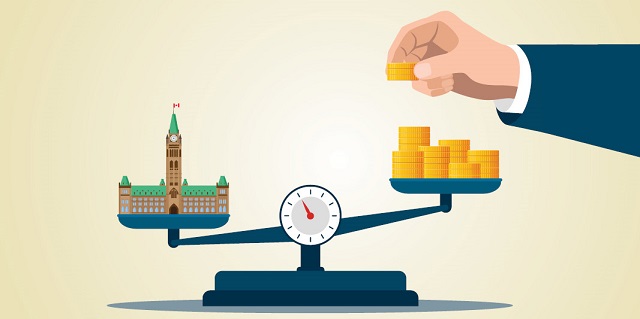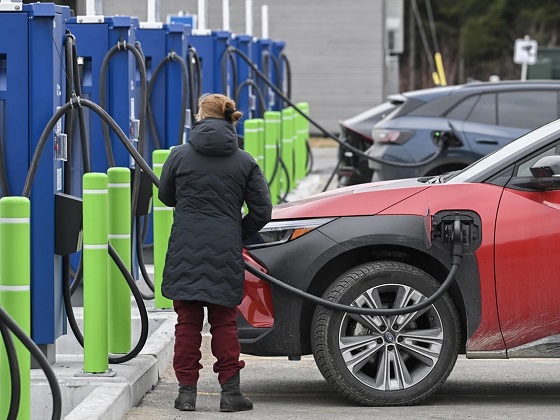Business
Spending restraint: Roadmap to a balanced budget

From the Fraser Institute
A Case for Spending Restraint: How the Federal Government Can Balance the Budget
By Grady Munro and Jake Fuss
Since 2015, there has been a deterioration in the federal government’s fiscal situation. Annual
nominal program spending has increased an estimated $193.6 billion since 2014/15; adjusted for
inflation and population growth this represents an extra $2,330 per person. Prior to the COVID
pandemic, spending increased faster than population, inflation, and other relevant economic
indicators. These spending increases have resulted in a string of large budgetary deficits that have
contributed to an estimated $941.9 billion increase in gross federal debt from 2014/15 to 2023/24.
This accumulation of debt, along with recent hikes in interest rates, has raised the cost of interest
on the federal debt to one of the largest budget expense items.
Moving forward, the federal government plans to slow nominal spending growth, which will keep inflation-adjusted, per-person spending relatively constant to 2026/27. Despite this, the federal government will continue running budget deficits and accumulating debt. It is also uncertain whether the federal government’s current estimates are truly reliable as the estimates do not incorporate expected spending on pharmacare or the level of defence spending to meet Canada’s NATO commitment. Moreover, the federal government’s track record of exceeding previous spending commitments calls into question the reliability of the current spending targets. Therefore, it is clear the federal government is not implementing the level of spending restraint necessary to reverse course towards a stable fiscal situation.
An approach to federal finances that continues to run budget deficits and accumulate debt is economically harmful to both current and future generations of Canadians. Research shows that significant increases in debt-financed spending harm economic growth by reducing capital accumulation and labour productivity.
Furthermore, accumulating debt today increases the tax burden on future generations of Canadians, as they will be responsible for paying off this debt. Despite these effects, the federal government plans to continue running deficits and accumulating debt for the foreseeable future.
This need not be the case. The federal government can undertake decisive spending reform starting in 2024— similar to the reform by the Chrétien government in the 1990s—that balances the budget within a year or two. The federal government could balance the budget in 2026/27 by limiting annual growth in nominal program spending to 0.3% for two years. This would result in a 5.9% reduction in real per-person spending. Alternatively, the budget could be balanced in 2025/26 if the federal government reduces spending 4.3% for one year; the next year, 2026/27, would see a budgetary surplus. In this scenario, inflation-adjusted per-person spending would decline by 7.5%. Key trade-offs between the two approaches include the extent of the spending reform and the speed of the return to balanced budgets. Balancing the budget in one year, as opposed to two years, would
result in $30.0 billion less debt accumulated by 2026/27.
Though it is beyond the scope of this study to discuss how such spending reforms should be implemented, there are three areas that might be considered for reform. Business subsidies are a significant expense, yet research suggests they have little if any economic benefit, and may actually harm economic growth when governments pick winners and losers in a free market. Reviewing business subsidies might provide opportunities to find savings. Aligning government-sector wages
with those in the private sector would also provide savings, as government workers in Canada currently enjoy an 8.5% wage premium (on average) relative to comparable private-sector workers. Finally, studies show that government fiscal waste can be significant. From 1988 to 2013, more than 600 government failures cost the federal government between $158.3 billion and $197.1 billion. Moreover, more than 25% of all federal COVID spending was wasteful. Addressing inefficiencies within government might also reveal savings.

- Canada has seen a deterioration in the federal government’s fiscal situation since 2015. A distinct lack of spending restraint has resulted in a string of large budget deficits, which have contributed to rising government debt and debt interest costs.
- Despite current fiscal plans promising more of the same, the federal government could implement decisive spending reform starting in 2024/25, similar to reforms implemented in the 1990s, and balance the budget within one or two years.
- To balance the budget by 2026/27, the federal government would need to limit growth in annual nominal program spending to 0.3 percent for two years. This would translate to a 5.9 percent reduction in inflation-adjusted, per-person spending.
- Alternatively, the federal government could balance the budget in one year, by 2025/26, by reducing nominal program spending by 4.3 percent. Adjusted for inflation and population, this would be a 7.5 percent decrease. In 2026/27, the federal government could then record a $8.2 billion surplus even while increasing spending from the previous year.
- While this study does not provide an in-depth analysis of where potential savings should be found, research highlights three potential areas that could be targeted for spending reform: corporate welfare, aligning government-sector wages with those in the private sector, or eliminating government fiscal waste.
A Case for Spending Restraint in Canada: How the Federal Government Can Balance the Budget
Authors:
Local Business
Red Deer Downtown Business Association to Wind Down Operations

The Downtown Business Association (DBA) Board of Directors has made the decision to wind down the Association’s operations at the end of 2025.
The Board determined that the Association is no longer able to operate sustainably under the financial framework available for 2026. After exploring all reasonable alternatives, the Board concluded that it could not continue without reducing services to a level that would no longer provide meaningful value to levy-paying businesses.
The DBA does not receive any operating funding from City Hall in a regular year, all funds raised are through Business Improvement Area Levy that consists of a mandatory levy placed on all businesses operating within the Business Improvement Area. These funds are legislated under the Municipal
Government Act, to be used to promote the Business Improvement Area, which is achieved through marketing and event initiatives along with providing advocacy support primarily to local government on behalf of the business community.
In recent years, the DBA has been a committed advocate for re-examining the approach to Downtown Governance. The Board has consistently maintained that the responsibility for funding downtown initiatives in such a socially charged environment should not rest solely with the business community.
Despite their efforts, the DBA recognized that the funds generated through the Business Improvement Area Levy were insufficient to effectively address the growing challenges of the current operating environment. This ongoing financial strain highlighted the need for a more equitable and sustainable
model to re-establish the downtown as a safe and welcoming heart of the city.
At the annual DBA budget presentation to City Hall, the DBA requested the essential funding needed to implement the Greater Downtown Governance Committee’s recommendations — work that the DBA is uniquely positioned to lead and has been delivering despite depleting resources for many years. The request was not approved. Instead, The City offered a one-time $100,000 Grant-in-Lieu, paired with a proposed 60% increase to the Business Improvement Area levy in 2026.
After careful analysis, the Board concluded that increasing the levy would place undue strain on already challenged businesses and compromise the DBA’s role as a trusted advocate. Operating with the reduced funding of $225,000 would require further staff reductions in an already under resourced environment and a significant reduction in programs, making it impossible to deliver the level of support that downtown businesses deserve and vitally need.
Beginning January 1, 2026, the City of Red Deer will become the primary contact point for matters previously supported by the DBA, including downtown support programs, business-district coordination, events, safety and cleanliness support, and stakeholder engagement. The DBA will work with City staff to support a smooth transition.
The DBA will continue to provide Clean Team services through the delivery of the City-funded environmental contract until February 1st, 2026.
Quote from CEO, Amanda Gould:
“To our business community, we have always operated with your best interests in our heart, continually driving the vision of a thriving downtown environment that serves every member of our community. The changes ahead will have a significant impact on downtown, as there will no longer be an organization dedicated to ensuring the downtown remains top-of-mind, leading events, marketing initiatives, or advocating on your behalf. It is likely you will experience less coordinated support and collective representation.
After 13 years of service to you and our beautiful downtown, it is with great personal sadness that we find ourselves here, but our message remains clear – addressing the unique challenges of our downtown should not rest solely on your shoulders. We cannot, in good faith, collect a levy that does not enable us to provide the essential services needed for our evolving downtown landscape”.
Quote from DBA Board Chair, Brandon Bouchard:
“The incredible staff at the Downtown Business Association have consistently delivered on their mandate with outstanding dedication and effectiveness. Through their efforts, they have successfully promoted the downtown area, organized impactful marketing and event initiatives, and provided steadfast
advocacy support for the business community. Their work has extended well beyond the legislated requirements, as they have proactively responded to the evolving needs of downtown businesses, adapting to challenges and supporting operations within a complex and changing environment.
Despite the staff’s relentless commitment to positioning the DBA as an effective leader for downtown interests, the absence of a sustainable funding model has made it impossible to continue delivering meaningful support. The Board cannot, in good conscience, propose a levy that does not enable the
Association to meet the required level of service, address the shifting priorities of the business community, or respond to the continually evolving needs of the downtown”.
Agriculture
Growing Alberta’s fresh food future

A new program funded by the Sustainable Canadian Agricultural Partnership will accelerate expansion in Alberta greenhouses and vertical farms.
Albertans want to keep their hard-earned money in the province and support producers by choosing locally grown, high-quality produce. The new three-year, $10-milllion Growing Greenhouses program aims to stimulate industry growth and provide fresh fruit and vegetables to Albertans throughout the year.
“Everything our ministry does is about ensuring Albertans have secure access to safe, high-quality food. We are continually working to build resilience and sustainability into our food production systems, increase opportunities for producers and processors, create jobs and feed Albertans. This new program will fund technologies that increase food production and improve energy efficiency.”
“Through this investment, we’re supporting Alberta’s growers and ensuring Canadians have access to fresh, locally-grown fruits and vegetables on grocery shelves year-round. This program strengthens local communities, drives innovation, and creates new opportunities for agricultural entrepreneurs, reinforcing Canada’s food system and economy.”
The Growing Greenhouses program supports the controlled environment agriculture sector with new construction or expansion improvements to existing greenhouses and vertical farms that produce food at a commercial scale. It also aligns with Alberta’s Buy Local initiative launched this year as consumers will be able to purchase more local produce all year-round.
The program was created in alignment with the needs identified by the greenhouse sector, with a goal to reduce seasonal import reliance entering fall, which increases fruit and vegetable prices.
“This program is a game-changer for Alberta’s greenhouse sector. By investing in expansion and innovation, we can grow more fresh produce year-round, reduce reliance on imports, and strengthen food security for Albertans. Our growers are ready to meet the demand with sustainable, locally grown vegetables and fruits, and this support ensures we can do so while creating new jobs and opportunities in communities across the province. We are very grateful to the Governments of Canada and Alberta for this investment in our sector and for working collaboratively with us.”
Sustainable Canadian Agricultural Partnership (Sustainable CAP)
Sustainable CAP is a five-year, $3.5-billion investment by federal, provincial and territorial governments to strengthen competitiveness, innovation and resiliency in Canada’s agriculture, agri-food and agri-based products sector. This includes $1 billion in federal programs and activities and $2.5 billion that is cost-shared 60 per cent federally and 40 per cent provincially/territorially for programs that are designed and delivered by provinces and territories.
Quick facts
- Alberta’s greenhouse sector ranks fourth in Canada:
- 195 greenhouses produce $145 million in produce and 60 per cent of them operate year-round.
- Greenhouse food production is growing by 6.2 per cent annually.
- Alberta imports $349 million in fresh produce annually.
- The program supports sector growth by investing in renewable and efficient energy systems, advanced lighting systems, energy-saving construction, and automation and robotics systems.
Related information
-

 Business2 days ago
Business2 days agoCanada Can Finally Profit From LNG If Ottawa Stops Dragging Its Feet
-

 Crime2 days ago
Crime2 days agoInside the Fortified Sinaloa-Linked Compound Canada Still Can’t Seize After 12 Years of Legal War
-

 Automotive15 hours ago
Automotive15 hours agoThe $50 Billion Question: EVs Never Delivered What Ottawa Promised
-

 National2 days ago
National2 days agoLiberal bill “targets Christians” by removing religious exemption in hate-speech law
-

 Energy2 days ago
Energy2 days agoLNG NOW! Canada must act fast to prosper in changing times
-

 Health1 day ago
Health1 day agoUS podcaster Glenn Beck extends a lifeline to a Saskatchewan woman waiting for MAiD
-

 Local Business12 hours ago
Local Business12 hours agoRed Deer Downtown Business Association to Wind Down Operations
-

 C2C Journal14 hours ago
C2C Journal14 hours agoWisdom of Our Elders: The Contempt for Memory in Canadian Indigenous Policy








